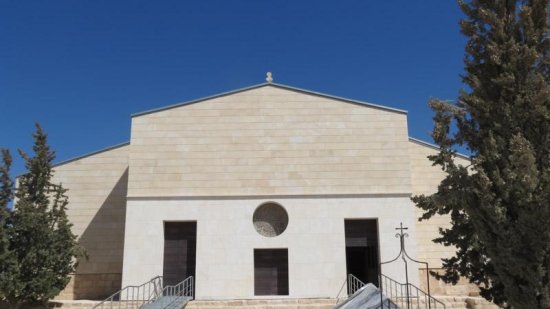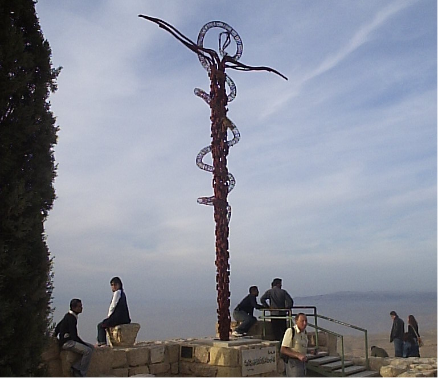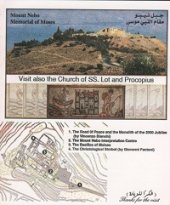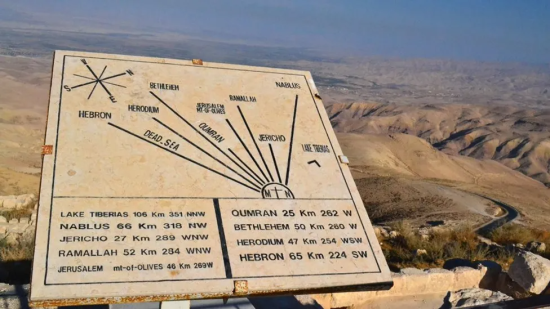The visit to Nebo

The panoramic view from Mount Pisgah reveals the Promised Land, as it did with Moses: from the Dead Sea through Herodium, Bethlehem and Jerusalem (46 kilometers away as the crow flies) to the pointed top of the Alexandreion and Jericho. At night you can see the lights of the cities glimmering.
The site, with the new basilica and the ruins of the vast Byzantine monastery, is entrusted to the care of the Custody of the Holy Land.
After the entrance of the site, a six-meter wide commemorative plaque recalls the visit of John Paul II to the Holy Land in 2000. On the front, in Latin, we read: “One God and Father of all, above all” (Ephesians 4: 6). On the north side, to the right, are depicted the Old Testament prophets, who ‘saw’ a glimpse of the future (1 Peter 1: 10-12).
On the back, “God is love,” is written in Arabic, which is “the invitation of Heaven and the message of the prophets.” Finally on the south side, to the left, we read again (this time in Greek): “God is love” (1 John 4: 8). The emblem of the Custody of the Holy Land can be seen above.
In the small museum some minor artifacts, especially ceramics, are exhibited, in addition to little models and illustrative tables, and two milestones of the Roman road that went from Heshbon to Livias (now Tell ar-Rame, near the place of the Baptism on the Jordan) bypassing Mount Nebo to the north.
The central column, in a group of three, is made of precious black and white marble from an imperial quarry, which was probably a gift from the emperor (Constantine?) to the local Christian community.
In the Byzantine basilica, mosaics were found in three layers, sometimes even four, covering a total surface of 700 square meters. They were secured and separated and almost all of them are now exhibited inside the new basilica.
The new basilica
Beginning in 1963, the basilica began to be restructured, initially as a simple protection for the remains of the memorial dedicated to Moses, and later (from 2008) so that it could serve simultaneously as a sanctuary, museum and shelter for antiquities.
The works, completed in 2016, were slowed down first by the sudden death of the archaeologist and construction site manager Michele Piccirillo and later by the development of new preservation techniques, or rather by the rediscovery of the ancient mosaic technique. In fact, it was proved that the methods of fixing the tesserae with cement used in the 60s and 70s will, in the long run, damage the work, while the lime mortar method takes more time, but lasts longer.
The new church is wider than its Byzantine predecessor, as it also incorporates additional rooms and side chapels. However, the unusual presbytery with three apses, in the shape of a clover, corresponds to the original. In the lower stone layer (the original one), we note that the architectural elements were made with reused materials from a previous building; for example: a column base that now appears overturned. Unfortunately, we know almost nothing about this original structure, especially since finds from that era are very rare. It could be a pagan construction, or also a Jewish or Samaritan memorial in honor of Moses. In fact, the remains of a Samaritan inscription were found, but it is almost incomprehensible: these are now preserved in Jerusalem at the museum of the Studium Biblicum Franciscanum.
The windows of the apse, which date back to the first “makeshift” version of the church, show Moses and Aaron on the left with the water that flows from the rock (Exodus 17: 1-6); in the center, Moses interceding for the people, supported by Aaron and Cur (Exodus 17: 8-13); on the right the death of Moses here, on Mount Nebo.
During the works, the important discovery of a tomb that was never used (because it is too shallow and shows no trace of burial) took place by chance in the central nave. For this tomb, the alabaster from an older (Herodian?) monument was reused. Experts are almost certain to have laid their hands on the “Moses’ sepulcher” described by the pilgrim Egeria:
“In this church, where the ambo stands, I noticed a slightly elevated area, more or less the size of a tomb. I asked those holy men what it was about, and they replied: ‘Here holy Moses was deposed by the angels. Since, as it is written [Deuteronomy 34: 6], no man knows where his tomb is, then it was certainly the angels.’”
For the reorganization of the mosaics, the following criterion was followed: of the various mosaic layers, the best preserved or most richly decorated part was relocated to its original location. The rest of the mosaics were hung on the walls as close as possible, therefore almost all the works, belonging to the different phases of the building's history, found a place in the new basilica.Modern sculpture
Modern sculpture
The modern sculpture seen on the square in front of the church was built in 1983-84 by the Florentine Gian Paolo Fantoni: the copper serpent raised by Moses in the desert is clinging to a cross-shaped shaft. The artist connects the Old Testament history with Christology, as did the evangelist John. In reality, it is not clear where the copper snake was raised during the Exodus, nor is the proximity to Mount Or helping to solve the riddle.
“They left Mount Hor by the road to the Sea of Suph, to skirt round Edom. On the way the people lost patience.They spoke against God and against Moses, 'Why did you bring us out of Egypt to die in the desert? For there is neither food nor water here; we are sick of this meagre diet. At this, God sent fiery serpents among the people; their bite brought death to many in Israel.The people came and said to Moses: 'We have sinned by speaking against Yahweh and against you. Intercede for us with Yahweh to save us from these serpents.' Moses interceded for the people, and Yahweh replied, 'Make a fiery serpent and raise it as a standard. Anyone who is bitten and looks at it will survive.' Moses then made a serpent out of bronze and raised it as a standard, and anyone who was bitten by a serpent and looked at the bronze serpent survived” (Numbers 21: 4-9).
“As Moses lifted up the snake in the desert, so must the Son of man be lifted up so that everyone who believes may have eternal life in him” (John 3: 14-15).















